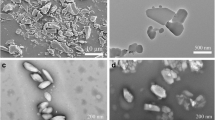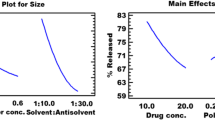Abstract
The present work was undertaken with the objectives of improving the dissolution velocity, related oral bioavailability, and minimizing the fasted/fed state variability of repaglinide, a poorly water-soluble anti-diabetic active by exploring the principles of nanotechnology. Nanocrystal formulations were prepared by both top-down and bottom-up approaches. These approaches were compared in light of their ability to provide the formulation stability in terms of particle size. Soluplus® was used as a stabilizer and Kolliphor™ E-TPGS was used as an oral absorption enhancer. In vitro dissolution profiles were investigated in distilled water, fasted and fed state simulated gastric fluid, and compared with the pure repaglinide. In vivo pharmacokinetics was performed in both the fasted and fed state using Wistar rats. Oral hypoglycemic activity was also assessed in streptozotocin-induced diabetic rats. Nanocrystals TD-A and TD-B showed 19.86 and 25.67-fold increase in saturation solubility, respectively, when compared with pure repaglinide. Almost 10 (TD-A) and 15 (TD-B)-fold enhancement in the oral bioavailability of nanocrystals was observed regardless of the fasted/fed state compared to pure repaglinide. Nanocrystal formulations also demonstrated significant (p < 0.001) hypoglycemic activity with faster onset (less than 30 min) and prolonged duration (up to 8 h) compared to pure repaglinide (after 60 min; up to 4 h, respectively).







Similar content being viewed by others
References
International Diabetes Federation. 2011: 5th ed.; www.idf.org/diabetesatlas/papers. Accessed 28 April 2014
Hatorp V. Clinical pharmacokinetics and pharmacodynamics of repaglinide. Clin Pharmacokinet. 2002;41:471–83. doi:10.2165/00003088-200241070-00002.
Nattrass M, Lauritzen T. Review of prandial glucose regulation with repaglinide: a solution to the problem of hypoglycaemia in the treatment of Type 2 diabetes. Int J Obes Relat Metab Disord. 2000;24 Suppl 3:S21–31. doi:10.1038/sj.ijo.0801422.
Mandic Z, Gabelica V. Ionization, lipophilicity and solubility properties of repaglinide. J Pharm Biomed Anal. 2006;41:866–71. doi:10.1016/j.jpba.2006.01.056.
Hatorp V, Oliver S, Su CA. Bioavailability of repaglinide, a novel anti-diabetic agent, administered orally in tablet or solution form or intravenously in healthy male volunteers. Int J Clin Pharmacol Ther. 1998;36:636–41.
Bidstrup TB, Bjornsdottir I, Sidelmann UG, Thomsen MS, Hansen KT. CYP2C8 and CYP3A4 are the principal enzymes involved in the human in vitro biotransformation of the insulin secretagogue repaglinide. Br J Clin Pharmacol. 2008;56:305–14. doi:10.1046/j.0306-5251.2003.01862.x.
Chang C, Bahadduri PM, Polli JE, Swaan PW, Ekins S. Rapid identification of P-glycoprotein substrates and inhibitors. Drug Metab Dispos. 2006;34:1976–84. doi:10.1124/dmd.106.012351.
Hatorp V, Bayer T. Repaglinide bioavailability in the fed or fasting state [abstract]. J Clin Pharmacol. 1997;37:875.
Yuan G, Jiao L, Xuan Q, Jianjun Z. Co-amorphous repaglinide—saccharin with enhanced dissolution. Int J Pharm. 2013;450:290–5. doi:10.1016/j.ijpharm.2013.04.032.
Kavitha R, Sathali AAH. Enhancement of solubility of repaglinide by solid dispersion technique. Int J Chem Sci. 2012;10:377–90.
Nicolescu C, Arama C, Nedelcu A, Monciu CM. Phase solubility studies of the inclusion complexes of repaglinide with β-cyclodextrin and β-cyclodextrin derivatives. Farmacia. 2010;58:620–8.
12)Troy P, Michal E, Mattucci M, Todd C, Keith P, Williams RO. Rapidly dissolving repaglinide powders produced by the ultra-rapid freezing process. AAPS PharmSciTech 2007; 8: Article 58. doi: 10.1208/pt0803058
Junghanns AH, Muller RH. Nanocrystal technology, drug delivery and clinical applications. Int J Nanomedicine. 2008;3:295–309. doi:10.2147/IJN.S595.
Peltonen L, Hirvonen J. Pharmaceutical nanocrystals by nanomilling: critical process parameters, particle fracturing and stabilization methods. J Pharm Pharmacol. 2010;62:1569–79. doi:10.1111/j.2042-7158.2010.01022.x.
Liversidge GG, Cundy KC. Particle size reduction for improvement of oral bioavailability of hydrophobic drugs 1: absolute oral bioavailability of nanocrystalline danazol in beagle dogs. Int J Pharm. 1995;125:91–7. doi:10.1016/0378-5173(95)00122-Y.
Hardung H, Djuric D, Ali S. Combining HME and solubilisation-soluplus—the solid solution. Drug Deliv Technol. 2010;10:20–7.
Dintaman JM, Silverman JA. Inhibition of P-glycoprotein by of d-α-tocopheryl PEG 1000 succinate (TPGS). Pharm Res. 1999;16:1550–6. doi:10.1023/A:1015000503629.
Yu L, Bridgers A, Polli J, Vickers A, Long S, Roy A. Vitamin E TPGS increases absorption flux of an HIV protease inhibitor by enhancing its solubility and permeability. Pharm Res. 1999;16:1812–7. doi:10.1023/A:1018939006780.
Wu SHW, Hopkins WK. Characteristics of d-α-tocopheryl PEG 1000 succinate for applications as an absorption enhancer in drug delivery systems. Pharm Technol. 1999;23:52–68.
Verma VSM, Panchagnula R. Enhanced paclitaxel oral absorption with Vitamin E-TPGS: effect on solubility and permeability in vitro, in situ, in vivo. Eur J Pharm Sci. 2005;25:445–53. doi:10.1016/j.ejps.2005.04.003.
Christiansen A, Backensfeld T, Denner K, Weitschies W. Effects of non-ionic surfactants on cytochrome P450-mediated metabolism in vitro. Eur J Pharm Biopharm. 2011;78:166–72. doi:10.1016/j.ejpb.2010.12.033.
Johnson BM, Charman WN, Porter CJH. An in vitro examination of the impact of polyethylene glycol 400, pluronic P85 and vitamin E D-α-tocopheryl polyethylene glycol 1000 succinate on P-glycoprotein efflux and enterocyte-based metabolism in excised rat intestine. AAPS PharmSciTech. 2002;4:E40. doi:10.1208/ps040440.
Dressman JB, Amidon GL, Reppas C, Shah VP. Dissolution testing as a prognostic tool for oral drug absorption: immediate release dosage. Pharm Res. 1998;15:11–22. doi:10.1023/A:1011984216775.
Jantratid E, Janssen N, Chokshi H, Tang K, Dressman J. Designing bio-relevant dissolution tests for lipid formulations: case example—lipid suspension of RZ-50. Eur J Pharm Biopharm. 2008;69:776–85. doi:10.1016/j.ejpb.2007.12.010.
Verma S, Gokhale R, Burgess DJ. A comparative study of top-down and bottom-up approaches for the preparation of micro/nanosuspensions. Int J Pharm. 2009;380:216–22. doi:10.1016/j.ijpharm.2009.07.005.
He W, Lu Y, Qi JP, Chen LY, Hu FQ, Wu W. Food proteins as novel nanosuspension stabilizers for poorly water-soluble drugs. Int J Pharm. 2013;441:269–78. doi:10.1016/j.ijpharm.2012.11.033.
ICH Harmonised Tripartite Guideline. Stability testing of new drug substances and products Q1A (R2), version 4 dated 6 February, 2003
Cerdeira AM, Mazzotti M, Bruno G. Miconazole nanosuspensions: influence of formulation variables on particle size reduction and physical stability. Int J Pharm. 2010;396:210–8. doi:10.1016/j.ijpharm.2010.06.020.
Jinno J, Kamada N, Miyake M, Yamada K, Mukai T, Odomi M. Effect of particle size reduction on dissolution and oral absorption of a poorly water-soluble drug, cilostazol, in beagle dogs. J Control Release. 2006;111:56–64. doi:10.1016/j.jconrel.2005.11.013.
Rahigude A, Bhutada P, Kaulaskar S, Aswar M, Otari K. Participation of antioxidant and cholinergic system in protective effect of naringenin against type-2 diabetes-induced memory dysfunction in rats. Neuroscience. 2012;226:62–72. doi:10.1016/j.neuroscience.2012.09.026.
Ruzilawati AB, Wahab MSA, Imran A, Ismail Z, Gana SH. Method development and validation of repaglinide in human plasma by HPLC and its application in pharmacokinetic studies. J Pharm Biomed Anal. 2007;43:1831–5. doi:10.1016/j.jpba.2006.12.010.
Amrani FE, Rhallab A, Alaoui T, Badaoui KE, Chakir S. Hypoglycaemic effect of Thymelaea hirsuta in normal and streptozotocin-induced diabetic rat. J Med Plants Res. 2009;3:625–9.
Andrade-Cetto A, Wiedenfeld H, Revilla MC, Islas S. Hypoglycaemic effect of Equisetum myriochaetum aerial parts on streptozotocin diabetic rats. J Ethnopharmacol. 2000;72:129–33. doi:10.1016/S0378-8741(00)00218-X.
Kipp JE, Wong T, Chung J, Doty MJ, Werling J, Rebbeck CL. Method for preparing submicron particle suspension. U S Patent. 2005;6:884,436.
Guo Z, Zhang M, Li H, Wang J, Kougoulos E. Effect of ultrasound on antisolvent crystallisation process. J Cryst Growth. 2005;273:555–63. doi:10.1016/j.jcrysgro.2004.09.049.
Dhumal RS, Biradar SV, Paradkar AR, York P. Particle engineering using sonocrystallization: salbutamol sulphate for pulmonary delivery. Int J Pharm. 2009;368:129–37. doi:10.1016/j.ijpharm.2008.10.006.
Yao JH, Elder KR, Guo H, Grant M. Theory and simulation of Ostwald ripening. Physical review B. 1993;47(21):110–25. doi:10.1103/PhysRevB.47.14110.
Teeranachaideekul V, Junyaprasert V, Souto E, Muller R. Development of ascorbyl palmitate nanocrystals applying the nanosuspension technology. Int J Pharm. 2008;354:227–34. doi:10.1016/j.ijpharm.2007.11.062.
Kesisoglou F, Panmai S, Wu Y. Nanosizing—oral formulation development and biopharmaceutical evaluation. Adv Drug Del Rev. 2007;59:631–44. doi:10.1016/j.addr.2007.05.003.
Gao L, Liu G, Ma J, Wang X, Zhou L, Li X. Drug nanocrystals: in vivo performances. J Control Release. 2012;160:418–30. doi:10.1016/j.jconrel.2012.03.013.
Li Xi G, Xu Y, Wang Y. Preparation of fenofibrate nanosuspension and study of its pharmacokinetic behaviour in rats. Drug Dev Ind Pharm. 2009;35:827–33. doi:10.1080/03639040802623941.
Parsa A, Saadati R, Abbasian Z, Aramaki SA, Dadashzadeh S. Enhanced permeability of etoposide across everted sacs of rat small intestine by vitamin E-TPGS. Iranian J Pharm Res. 2013;12:37–46.
Rege BD, Kao JPY, Polli JE. Effects of nonionic surfactants on membrane transporters in Caco-2 cell monolayers. Eur J Pharm Sci. 2002;16:237–46. doi:10.1016/S0928-0987(02)00055-6.
Ivora MD, Paya M, Villar A. A review of natural products and plants as potential anti-diabetic drugs. J Ethnopharmacol. 1989;27:243–75. doi:10.1016/0378-8741(89)90001-9.
Sharma SR, Dwivedi SK, Swarup D. Hypoglycaemic, anti hyperglycaemic and hypolipidemic activities of Cesalpinia bounducella seeds in rats. J Ethnopharmacol. 1997;58:39–44. doi:10.1016/S0378-8741(97)00079-2.
Acknowledgments
The authors thank USV Limited (Mumbai, India) for providing a gift sample of repaglinide. The authors also thank BASF Corporation (Germany) for providing gift samples of the excipients. Rahul Gadadare would also like to thank AICTE (New Delhi, India) for providing financial support in the form of Junior Research Fellowship.
Declaration of Interest
The authors report no conflict of interest.
Author information
Authors and Affiliations
Corresponding author
Rights and permissions
About this article
Cite this article
Gadadare, R., Mandpe, L. & Pokharkar, V. Ultra Rapidly Dissolving Repaglinide Nanosized Crystals Prepared via Bottom-Up and Top-Down Approach: Influence of Food on Pharmacokinetics Behavior. AAPS PharmSciTech 16, 787–799 (2015). https://doi.org/10.1208/s12249-014-0267-8
Received:
Accepted:
Published:
Issue Date:
DOI: https://doi.org/10.1208/s12249-014-0267-8




